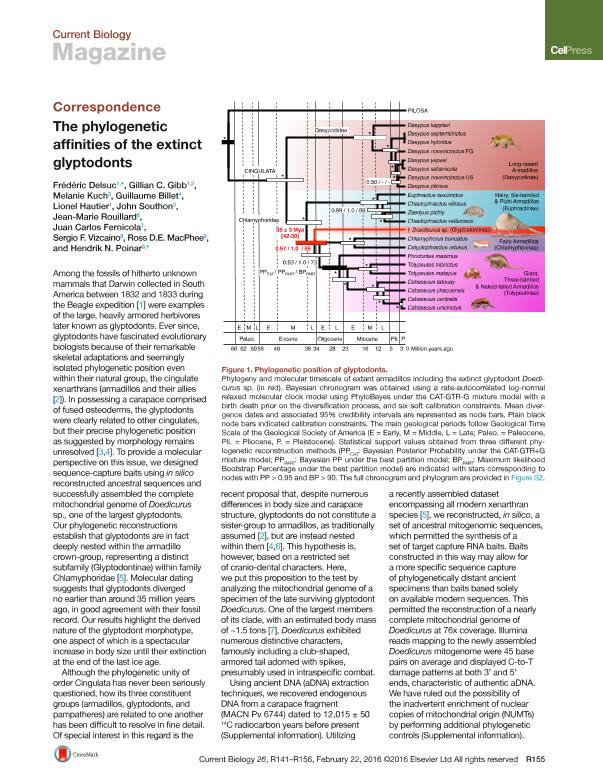Artículo
The phylogenetic affinities of the extinct glyptodonts
Delsuc, Frédéric; Gibb, Gillian C.; Kuch, Melanie; Billet, Guillaume; Hautier, Lionel; Southon, John; Rouillard, JJean Marie; Fernicola, Juan Carlos ; Vizcaíno, Sergio Fabián
; Vizcaíno, Sergio Fabián ; MacPhee, Ross D.E.; Poinar, Hendrik N.
; MacPhee, Ross D.E.; Poinar, Hendrik N.
 ; Vizcaíno, Sergio Fabián
; Vizcaíno, Sergio Fabián ; MacPhee, Ross D.E.; Poinar, Hendrik N.
; MacPhee, Ross D.E.; Poinar, Hendrik N.
Fecha de publicación:
02/2016
Editorial:
Cell Press
Revista:
Current Biology
ISSN:
0960-9822
e-ISSN:
1879-0445
Idioma:
Inglés
Tipo de recurso:
Artículo publicado
Clasificación temática:
Resumen
Among the fossils of hitherto unknown mammals that Darwin collected in South America between 1832 and 1833 during the Beagle expedition [1] were examples of the large, heavily armored herbivores later known as glyptodonts. Ever since, glyptodonts have fascinated evolutionary biologists because of their remarkable skeletal adaptations and seemingly isolated phylogenetic position even within their natural group, the cingulate xenarthrans (armadillos and their allies [2]). In possessing a carapace comprised of fused osteoderms, the glyptodonts were clearly related to other cingulates, but their precise phylogenetic position as suggested by morphology remains unresolved [3,4]. To provide a molecular perspective on this issue, we designed sequence-capture baits using in silico reconstructed ancestral sequences and successfully assembled the complete mitochondrial genome of Doedicurus sp., one of the largest glyptodonts. Our phylogenetic reconstructions establish that glyptodonts are in fact deeply nested within the armadillo crown-group, representing a distinct subfamily (Glyptodontinae) within family Chlamyphoridae [5]. Molecular dating suggests that glyptodonts diverged no earlier than around 35 million years ago, in good agreement with their fossil record. Our results highlight the derived nature of the glyptodont morphotype, one aspect of which is a spectacular increase in body size until their extinction at the end of the last ice age.
Palabras clave:
Phylogeny
,
Molecular
,
Glyptodonts
,
Doedicurus
Archivos asociados
Licencia
Identificadores
Colecciones
Articulos(CCT - LA PLATA)
Articulos de CTRO.CIENTIFICO TECNOL.CONICET - LA PLATA
Articulos de CTRO.CIENTIFICO TECNOL.CONICET - LA PLATA
Articulos(MACNBR)
Articulos de MUSEO ARG.DE CS.NAT "BERNARDINO RIVADAVIA"
Articulos de MUSEO ARG.DE CS.NAT "BERNARDINO RIVADAVIA"
Citación
Delsuc, Frédéric; Gibb, Gillian C.; Kuch, Melanie; Billet, Guillaume; Hautier, Lionel; et al.; The phylogenetic affinities of the extinct glyptodonts; Cell Press; Current Biology; 26; 4; 2-2016; R155-R156
Compartir
Altmétricas



